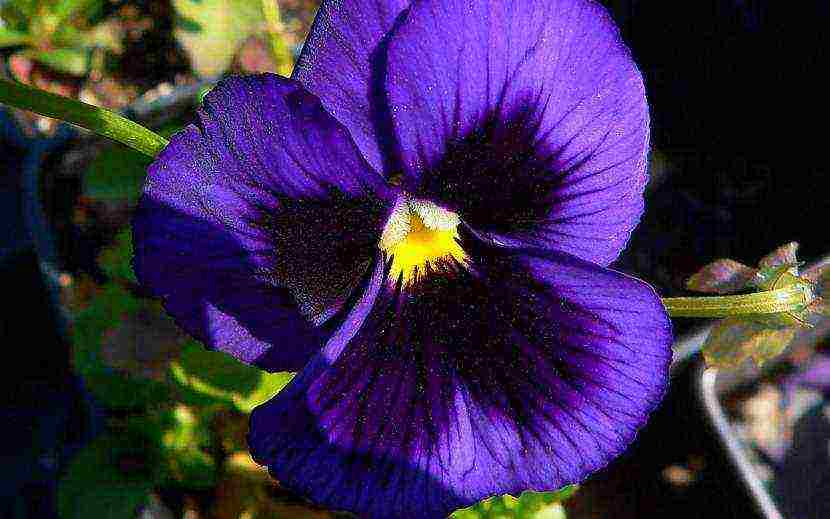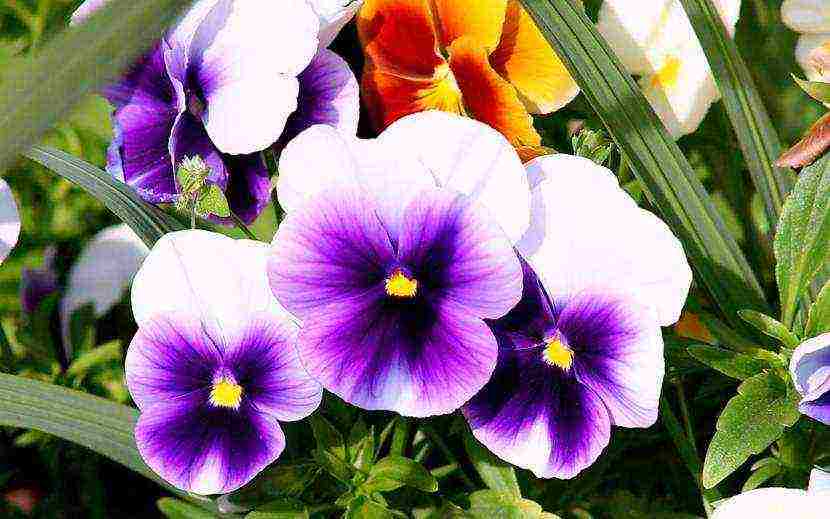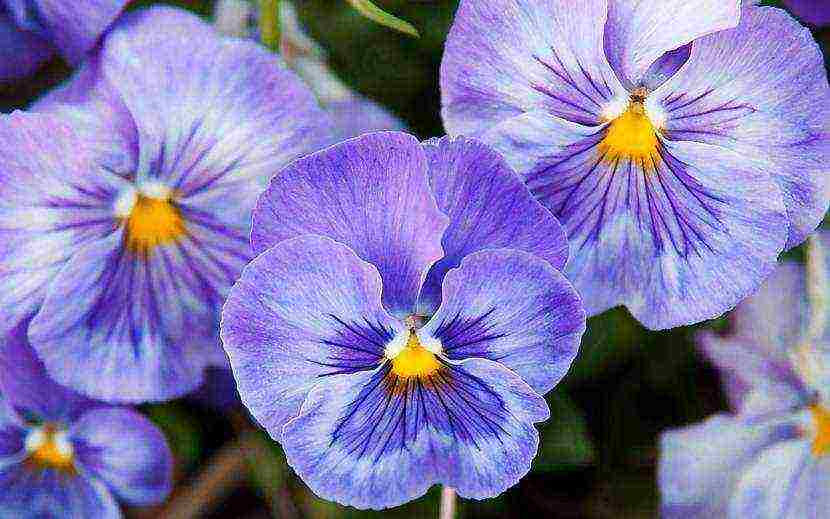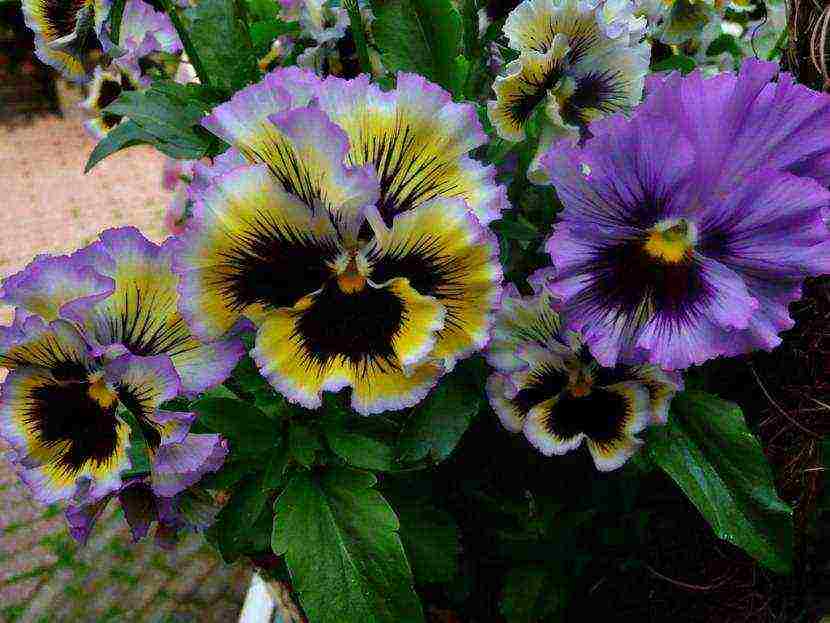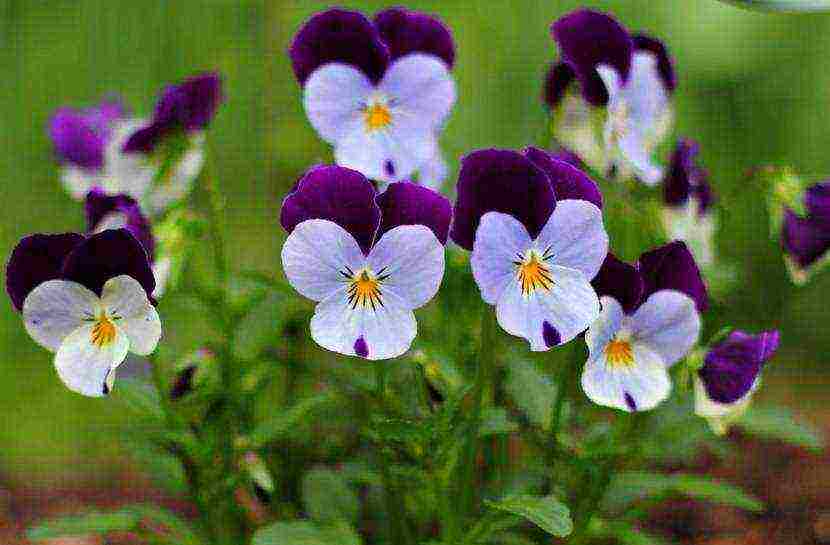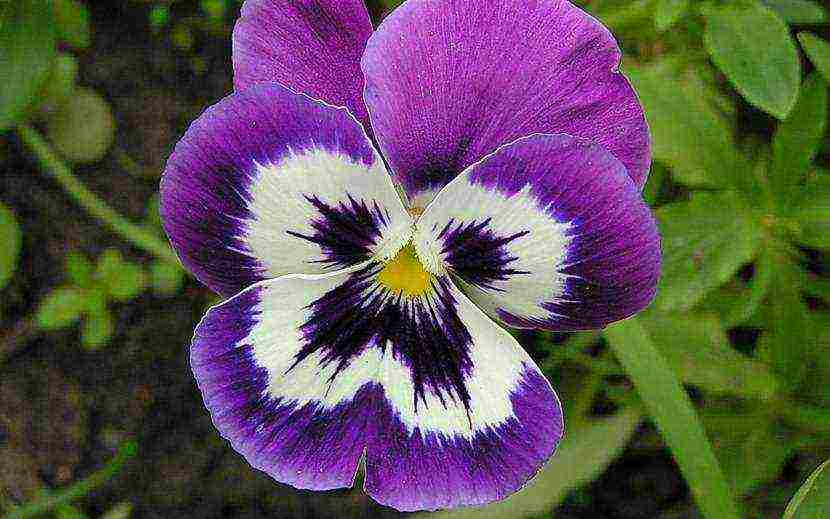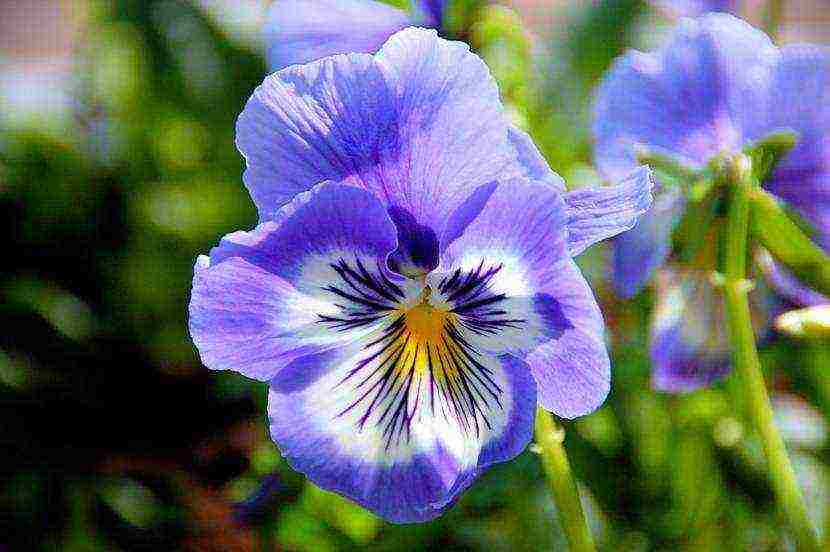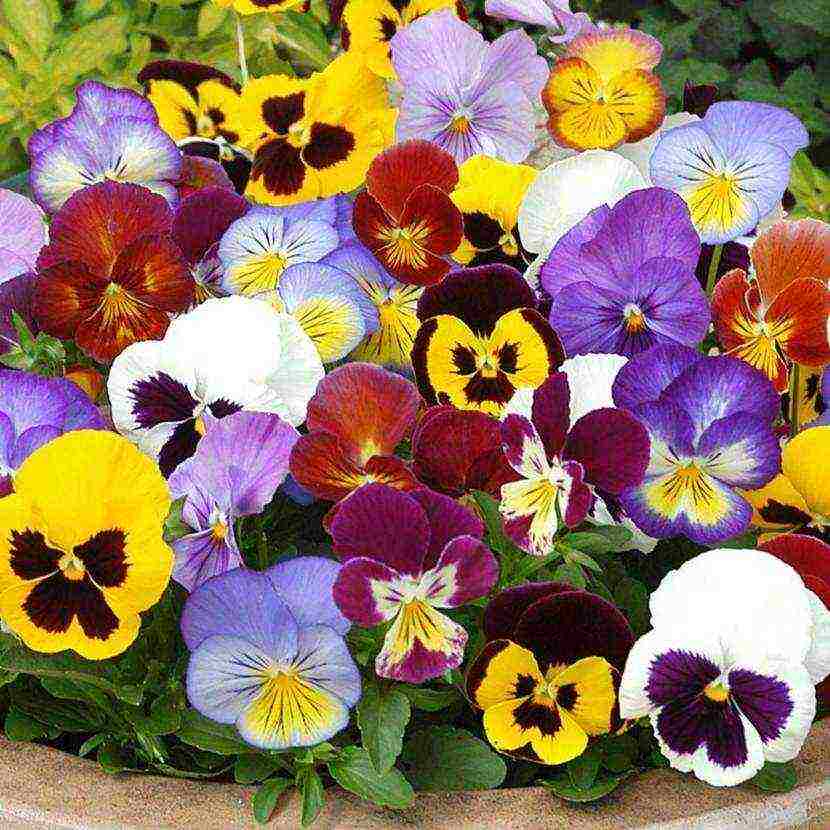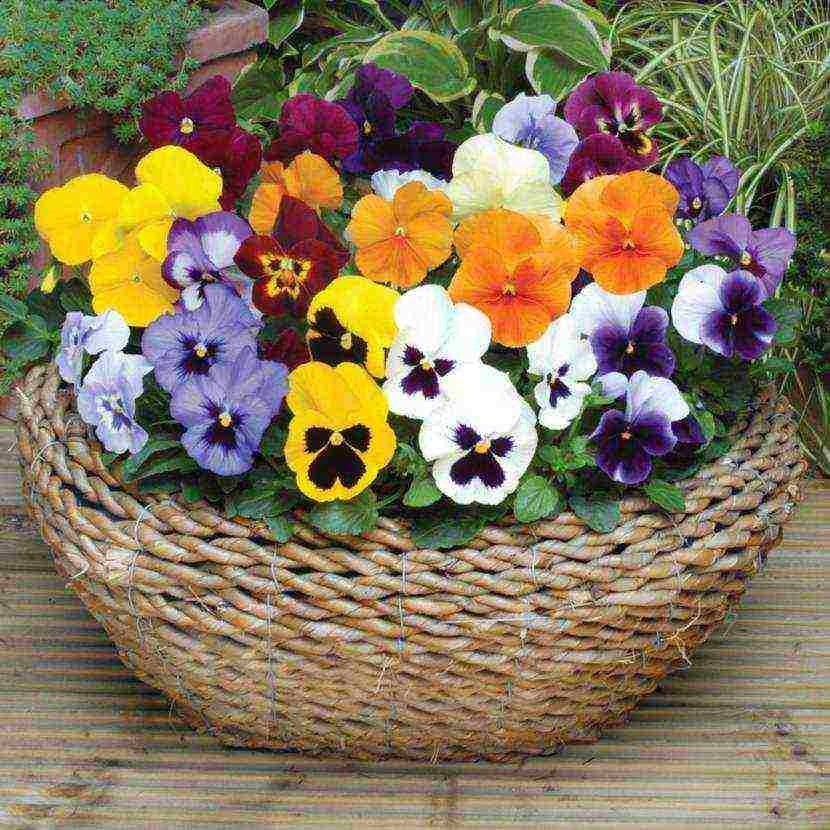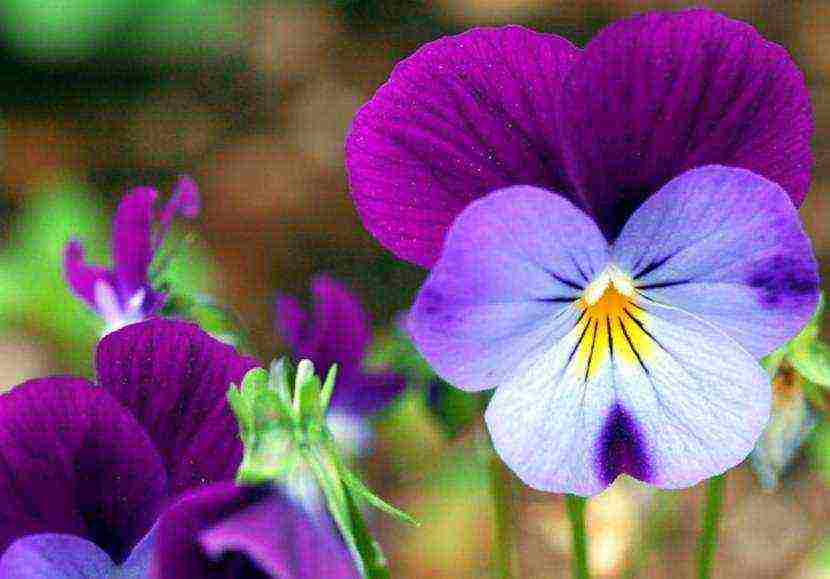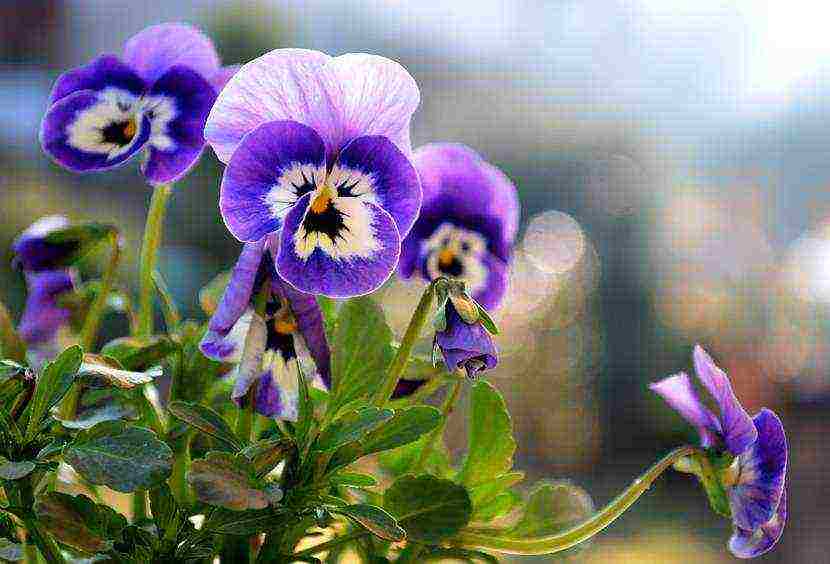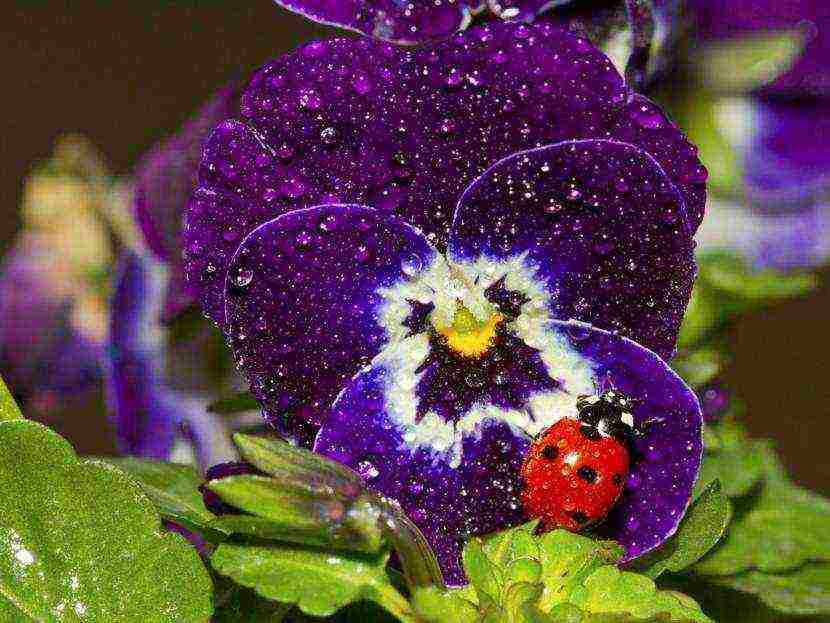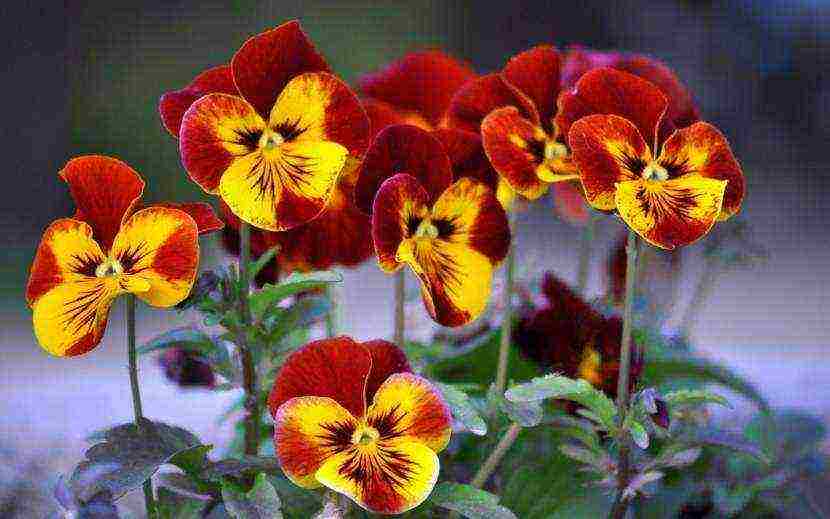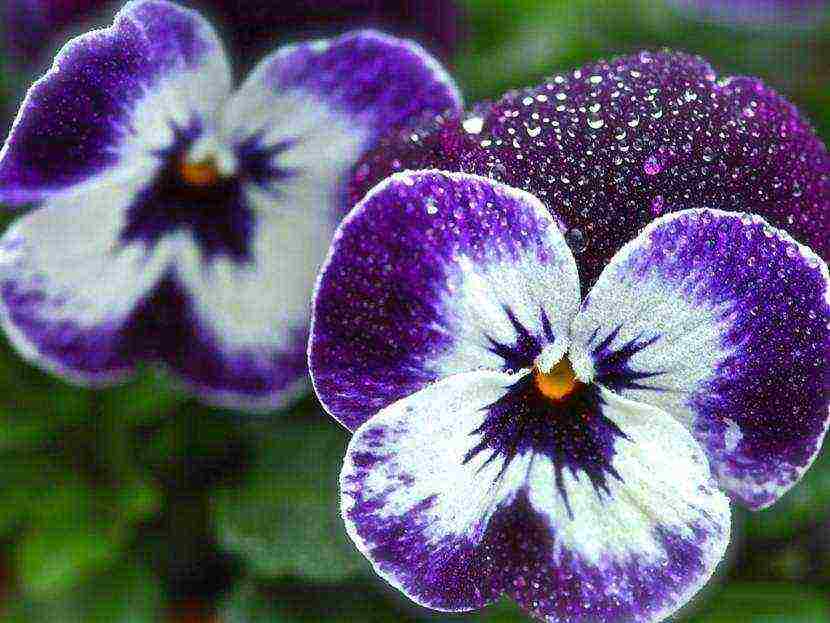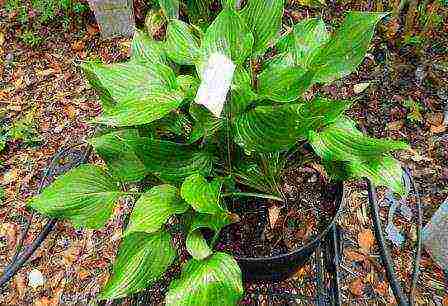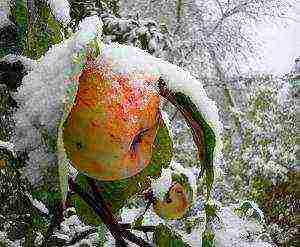Content
- 1 Pansies: growing and care
- 2 Pansies: photos of flowers and the best varieties
- 3 Growing seedlings of pansies: methods
- 4 Pansies: growing from seeds in the open field
- 5 Features of care for pansies
- 6 Growing pansies
- 7 Planting pansies
- 8 Features of caring for adult plants
- 9 Pansy diseases
- 10 Photo of pansies
Pansies or viola - a symbol of separation in France and Poland - are familiar to everyone. Low bushes with 2-3 flowers of various colors often decorate city flower beds and garden plots, and simply bloom on their own in parks and alleys. Growing pansies from seeds or seedlings is easy, given some subtleties.
Pansies: growing and care
The main problem facing those who want to plant pansies on their site is how to grow this adorable flower. Although it belongs to the perennial group, you can work with it as an annual or a biennial. The choice of a specific strategy depends on the region in which the planting is carried out. In particular, in the middle lane, the viola will not survive the harsh winter, and therefore it is grown as an annual. But in the southern regions, pansies are grown as a biennial.
However, this flower cannot be called fragile and not resistant to cold weather. Those bushes that were late planted in open ground and, therefore, did not have time to get stronger in time, will not tolerate frost. In addition, if the winter turns out to be practically snowless, and in the spring the daytime heat will be actively replaced by night frosts, the pansies will die. It is these temperature jumps that are characteristic of the sharply continental climate and the middle zone as a whole. All these nuances force gardeners to breed viola using the method used for annuals.
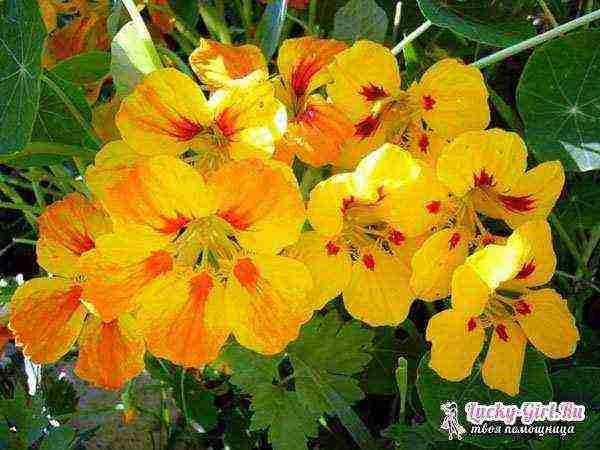
For example, pansies are necessarily protected from the cold by a covering material thrown onto the flower bed not only in late autumn, but also at the very beginning of spring. This will protect the plant from temperature changes in March and promote early flowering. In winter, it is additionally required to retain snow on top of the covering material in order to increase the heat. And in no case do viols plant in lowlands, where low temperatures and moisture accumulation are typically noted.
It should be noted that pansies can be grown and propagated not only by the seed method, but also by cuttings. For this purpose, in flowers growing in open ground, often closer to July (if we are talking about specimens planted in May), shoots with 2-3 nodules are cut off. Without any preliminary preparation, they are simply placed in the ground on a bed with the same soil composition as their "parents", and moistened with a spray bottle.
Their root system will develop within a month, and flowering can be expected only next year. Thus, this method is only suitable for areas with mild winters. But grafting is considered the best option for cultivating pansies, allowing you to prevent excessive growth of the bush.
Pansies: photos of flowers and the best varieties
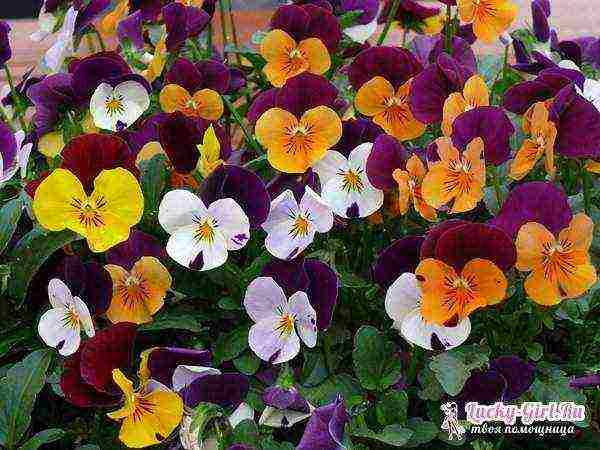
Novice gardeners believe that in addition to the classic violet-yellow color and the less expressive white-lilac color, pansies do not have any. However, this flower has many varieties that differ in the size of the bushes, and, of course, in color. Which ones to choose for your flower bed?
Among the small-flowered variants, the Snegurochka deserves attention. These are wonderful snow-white flowers with a diameter of 3-4 cm, contrasting with dark leaves.They are most often found in summer cottages, are sown and grow independently, more than unpretentious. A rather unusual variety is "Little Red Riding Hood". Its flowers are bright scarlet, as small as those of the previous specimen, but they certainly do not go unnoticed.
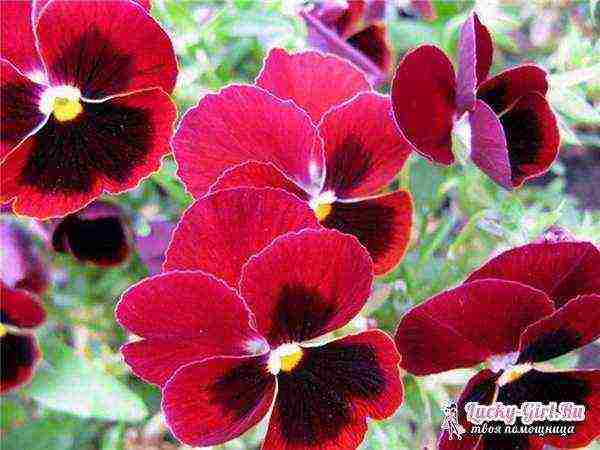
The group of large-flowered varieties is more popular with gardeners. The height of the bushes themselves can reach 15-20 cm, and the diameter of the flowers is 5-7 cm. The "Winter Sun" is distinguished by a yellow tint with velvety brown lower petals. "Magic of March", on the other hand, is a colder flower in color - a dark purple color, turning into black as it blooms, diameter - no more than 5.5 cm.
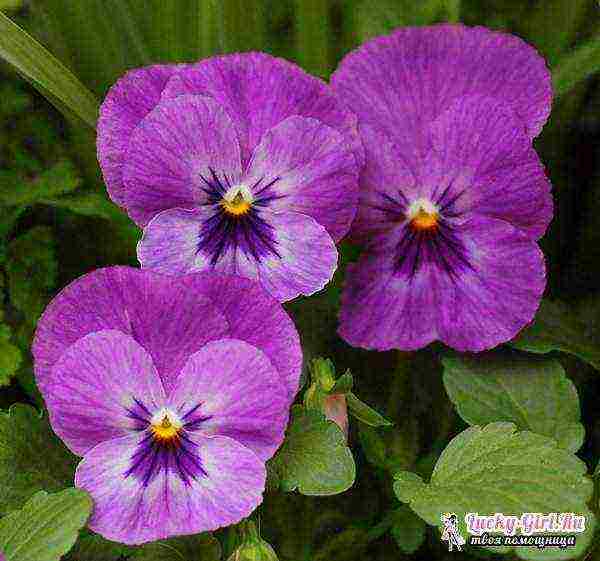
Another 1 group is gigantic. In fact, the bushes here are not so high (up to 30 cm), they just seem to be giants in comparison with their lower counterparts. In flowers, the diameter can reach 10-12 cm, the height of the leg - up to 11 cm. Interesting among them are the varieties "Golden-yellow", whose name directly speaks of the color, and "Blue": such a specimen also has purple blotches on blue petals ...
Growing seedlings of pansies: methods
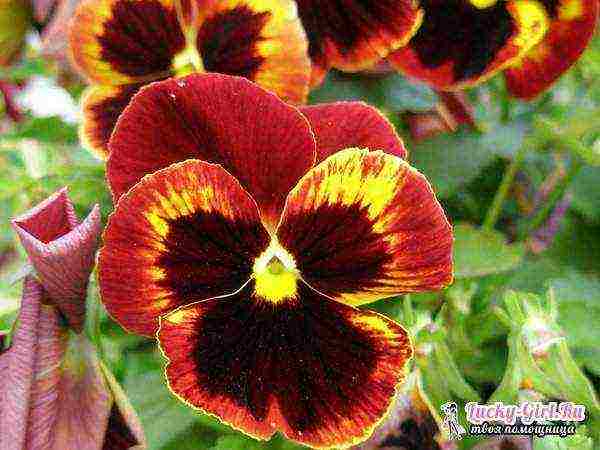
- It is necessary to understand both algorithms for growing pansies in order to subsequently choose the only convenient one for yourself. And immediately you need to mark the sowing time for seedlings for each method. If the viola is grown as an annual, the sowing is carried out already at the beginning of February. In this case, the beginning of summer will be marked by blooming buds. If you want to see flowers only next year, you can sow pansies on seedlings closer to the end of June.
- According to the algorithm for annual plants, viola is grown in cold regions of Russia. For this purpose, large boxes or pots are filled with a substrate consisting of sod soil and compost that has time to overheat. The ratio of these parts is equal. And after filling the containers, the soil must be carefully moistened and drawn in thin, shallow (1.5 cm) rows. Seeds will be poured into them, covered with a thin layer of substrate. At the end, it is carefully trampled down.
- It is recommended to cover the seedling container with glass while waiting for seedlings. For the same purpose, a dense film or even a plastic bag is used. However, they need to be shaken off the condensate every day. And the boxes themselves are kept in relative warmth, however, not as strong as for other seedlings: the upper limit of the temperature corridor is 15 degrees, the lower one is 10 degrees.
- As soon as the sprouts hatch - this will happen in 12-14 days - it is necessary to put containers with seedlings on a site that receives a sufficient amount of sunlight. It could be a windowsill or even a balcony. But the air temperature should not exceed 10 degrees. A pick is made when the plants get stronger. And the planting of seedlings of pansies in open ground is carried out no earlier than the 1st of May for an annual.
- How is picking done? To carry out it, you need to wait for the appearance of 3-4 leaves on the plant, and then prepare individual pots. They need to be filled not with sod with compost, but with earth from the site on which the flowers will subsequently grow. Seedlings should be removed from the current box carefully, taking care not to damage the roots.
- After that, the hardening stage begins, lasting a whole month. Pots with young plants are taken out on a ventilated balcony, under the sun's rays, where they last only 30 minutes at first, then 1.5 hours, then 2.5 hours, etc. If further transplantation into open ground is planned, it is carried out only a month after the pick. If pansies grow on a balcony or terrace, you can redistribute them to a flower bed at any time.
Pansies: growing from seeds in the open field
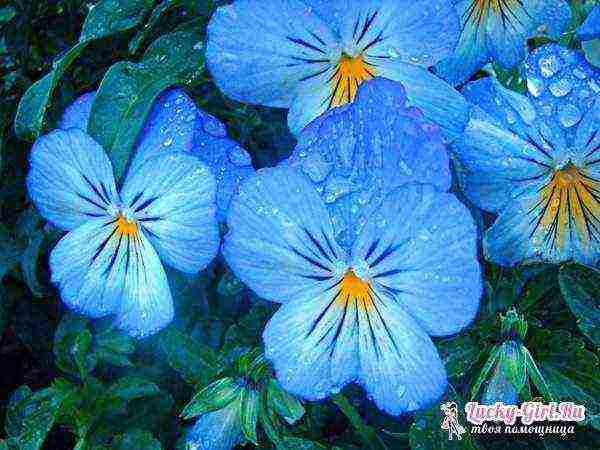
In open ground, pansies are sown only in the southern regions, and even there, most often - under a film or in a greenhouse. Nevertheless, the initial stage of growth in flowers should take place at the mildest possible temperature.In terms of timing, this is also June, and the sowing process itself does not differ much from that which was carried out for seedlings. Unless the garden bed is filled with sod and compost, but the most fertile area with well-drained soil is simply selected. In the loosened soil, grooves are drawn with a depth of 1-1.5 cm, seeds are densely laid in them. They are covered with earth and carefully moistened.
A pick in the open ground is also carried out after the detection of 3-4 sheets, and is carried out according to the 20 to 20 scheme. They are carried around the flower beds only after a month. Until that moment, you will have to conduct an active campaign for the care of pansies. In particular, pay attention to the issue of feeding them. For this, gardeners use mineral fertilizers, where nitrogen and phosphorus must be present. Ammonium nitrate and superphosphate work well. For 1 sq. these drugs are taken for 20-30 g.
Before the flowering period, the viola is diligently watered, especially if the summer is hot. Additionally, it is necessary to remove drying leaves and wilting flowers from her.
In order for pansies to survive the winter well, it is not recommended to shift the dates of their sowing to earlier dates.
For the rest, the rules for the care and cultivation of pansies are simple. These are standard procedures common to other flowering plants. It is especially pleasant that viola easily coexists in a flower bed with any bulbous. This means that it will exactly fit into the drawing of your site.

Describe all existing varieties and hybrids of pansies (Vittrock violets, viols) is very difficult, so let's talk about the most popular of them.
For convenience, we will use the generally accepted classification by the size of flowers.
Plants in which varieties differ only in color of flowers are usually combined into variety networks, so we give their descriptions.
Small-flowered violets (pansies)
The diameter of the flowers is up to 6 cm.
Wittrock mid-flowered violets
Diameter 6-7.5cm
| Photo | Description |
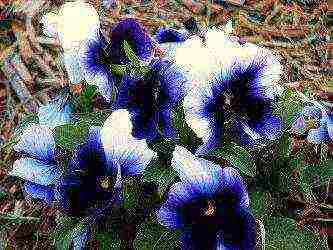 |
Trimardo. The variety series was created in France at the end of the 19th century. Gardeners love them for their fast growth, lush greenery, abundant flowering, and a classic flower shape. The best varieties of Trimardo pansies: Adonis - soft blue Cardinal - dark red Morenkenig - black, Lord Beaconsfield and Super Beaconsfield - blue-purple lower petals, white upper petals. |
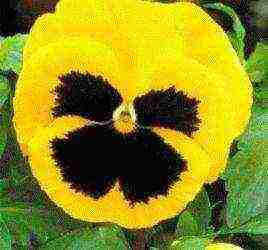 |
Schweizer Riesen (Swiss giant). Large flowers on low bushes, bred in 1927. The main advantages are early flowering, abundant flowering, excellent winter hardiness. The most famous varieties: Firmware - pure white, Firnengold - golden yellow, brown spot, Orange Marie - orange-apricot, Flamme - brick red Abendglut - dark red Alpensee - blue Bergwacht - blue-violet. |
| Crystal Bowl F1 (Crystal Bowl F1). Dwarf variety series, includes 12 varieties. Uniform color of flowers, numerous buds, dark green small leaves. They look best when planted in groups. An important advantage is that they tolerate heat better than other varieties, so they are chosen for planting in open areas. |
|
| Maxim F1 (Maxim Series F1). Hardy varieties that can withstand both heat and cold. Early and rather long flowering. The variety series includes 12 varieties, reflecting shades in the name (Maxim Orange, Maxim Rose, etc.), a distinctive feature is a dark eye. |
|
 |
Giant Forrunner F1 (Giant Forerunner F1). One of the best in terms of winter hardiness. Includes 15 varieties. |
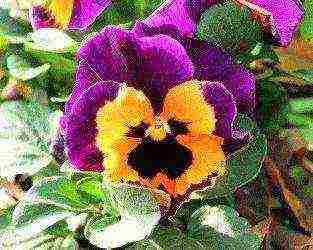 |
Joker F2 (Joker F2). The name was given because of the eye-catching color: flower petals are painted in two or sometimes three bright colors, have an interesting corolla shape. Includes 7 varieties of pansies, winter well. The Jolly Joker variety has exhibition medals. |
| Veseler Ice F1 (Weseler Eis F1). 8 varieties, all with abundant flowering. The color is different. |
|
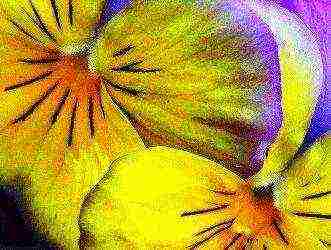 |
Spring Time F1 (Springtime F1). Early and long flowering, compactness, winter hardiness. There are 20 known varieties, one of the best is Spring Time Cassis, with a white thin strip along the edges of purple petals. |
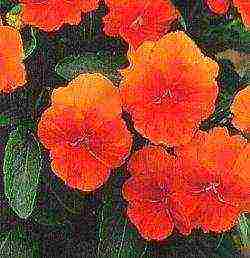 |
Padparadscha F1 (Padparadja F1). Orange-orange flowers, bright and long-lasting flowering. |
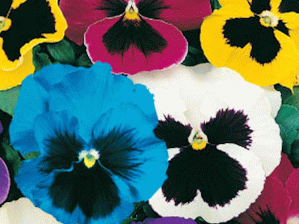 |
Quedlinburger Riesen (Quedlinburger Riesen). Sometimes the variety is called Quedlinburg gigantic violets, the variety has been known for a very long time.The advantage is early flowering, the disadvantage is poor winter hardiness. |
Large-flowered pansies.
The diameter of the flowers is 7.5-8.5cm.
| Photo | Description |
| Crown F1 (Crown F1). Gorgeous, bright, regular shape and color (no spots) flowers on dwarf bushes. They look great in group plantings, besides, they branch a lot. There are 9 varieties and mixtures for sale. |
|
| Imperial (Imperial) Very long flowering variety. A flower with a large spot. 12 varieties of various colors, of which the best are Imperial Frosty Rose, Imperial Antique Shades. |
|
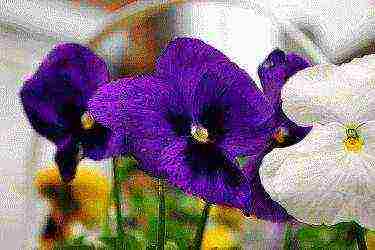 |
Regal F1 (Regal Series F1). Almost similar to the Crown variety series. The difference is the dark eyes on the petals. 7 varieties and mixtures of varieties. |
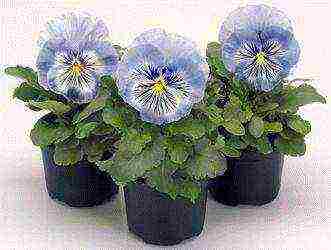 |
Cat's F1 (Cats Series F1). The variety series got its name "cats" because of the original pattern on the lower petals of flowers - thin stripes of contrast strictly in color, like a cat's whiskers. There are 4 varieties. |
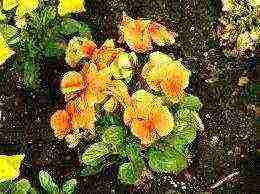 |
Fama F1 (Fama Series F1). A series of varieties of pansy for growing on the balcony, in pots or containers. Includes 17 varieties, flowers both monochromatic and variegated. |
| Shalon Supreme (Chalon Supreme). Original strong corrugated petals in white-yellow-lilac-violet tones. 5 varieties. |
|
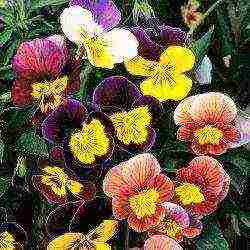 |
Fancy F1 (Fency Series F1). 24 varieties of various colors, there are monochromatic and with spots. |
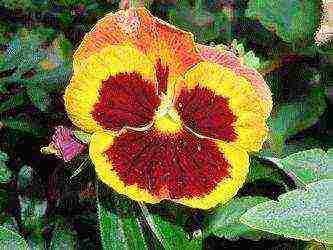 |
Power F1. It attracts with the brightness of the color combinations of the petals (for example, lemon with purple, red-brown with yellow). Compact bushes, flowering throughout the season. There are 13 known varieties. |
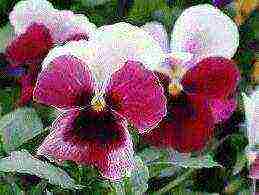 |
Dynamite. An interesting variety series with an unusual color. 13 varieties have bright spots on the lower petals, 10 varieties are monochromatic. Especially unusual Strawberry variety (Strawberry), included in this variety series - it changes color depending on the weather, it becomes brighter in the cold, and lighter in the heat. |
| Ultima F1 (Ultima Series F1). Resistant to cold weather - landed in Moscow by the day of the city (early September), bloomed almost to the point of snow. In turn, Ultima is divided into 3 groups. Ultima Baron - varieties with a very bright color: Red - red and yellow pansies, Merlot - burgundy with a white spot and light shading, Mahogany - purple with a bright yellow center, Ash - purple with a lemon spot. |
|
| Ultima Beeken - calmer color, mostly white with shades of yellow, orange, purple. | |
| Ultima Raidiens - absolutely amazing transitions of shades in each flower. Pink - from light pink to dark pink, Red - from orange to dark red, Blue - from cream to dark lilac. |
Giant pansies
Flowers over 8.5cm in diameter
Share the article on social media. networks: You may also be interested in:
Pansies or tricolor violet (viola) is a common variety of flowers that many gardeners love because of their simplicity in care and a variety of flowering. The color palette of the plant ranges from snow-white milky to black-purple. Thanks to the unusual pattern of the inflorescences and seed box, reminiscent of a human face, pansies are associated with many legends and superstitions. It is believed that the plant helps to find love, to bewitch a loved one. And in France and Poland, this particular flower is given after a long separation. Pansies will decorate any garden plot, flower bed or lawn with their charming look.
Description of the plant
Pansies (Viola Wittrock) belong to the group of perennial garden plants. However, due to their wide distribution in mid-latitudes, they are often grown for no more than two years. The height of the bush depends on the variety and climatic conditions, usually 15-30 centimeters. Outwardly, the flowers are very similar to violets, from which they were derived. The plant has a fibrous root system and an erect main stem.
 Pansies
Pansies
In the first month after planting, the bush is compact, and by the end of the first year of life, it can grow significantly in width. Flowers are single, but on one bush their number can be more than 10, the diameter of one inflorescence is up to 7 sentiments, depending on the variety. The color scheme of pansies is varied, which is often used by gardeners to decorate a flower bed or terrace. There are one-color varieties and three-color hybrids.
Many growers love this plant for its early flowering, which falls in April-May, when other plants are still growing.
Types and varieties
With the help of selection, numerous varieties of pansies have been bred, which are distinguished by their growth characteristics, resistance to adverse climatic conditions, diseases, and also have various shades of petals. There are more than 400 varieties of this plant, divided into groups depending on the size of the flower.
Small-flowered
The diameter of one flower in these species does not exceed 6 centimeters.
- Hemalis winter... This is a collective name for numerous varieties of pansies that are distinguished by early and very long flowering. They are frost resistant and compact, which will allow them to be grown even on the balcony. The most famous varieties of Hemalis: Nordpol (white flowers), Helios (bright yellow), Mars (deep blue), Jupiter (white-red petals);
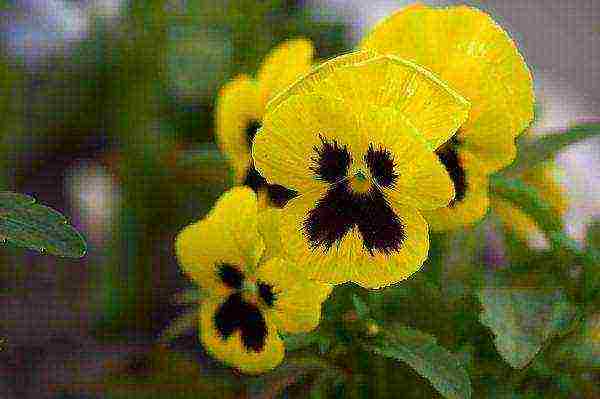 Helios
Helios
- F1 wagon... This group includes 10 varieties, distinguished by small bushes and abundant flowering;
- Rococo... This variety is characterized by ruffled purple petals;
- Flamenco F1... A variety that does not tolerate frost, but has a unique color - a spreading yellow spot in the center of a red-orange petal.
Mid-flowered
These varieties have a diameter of flowers from 6 to 7.5 centimeters.
- Trimardo... One of the oldest types of pansies. They have a spreading bush and abundant flowering. The flower shape is classic, the color depends on the variety. For example, Adonis (light blue petals), Cardinal (dark red), Morenkenig (black);
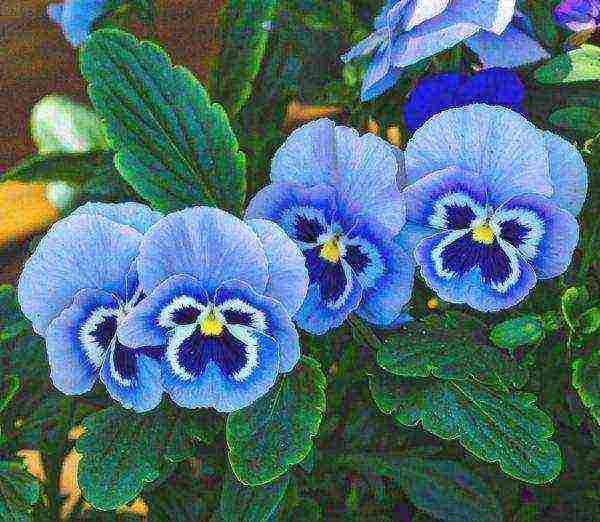 Adonis
Adonis
- Swiss giant... The advantage of this species is the early onset of flowering and unique resistance to frost. The most famous varieties of this species are Firneshnee (white petals), Flamme (orange-red), Bergwacht (purple-blue).
- Joker F2... The petals of this hybrid species are painted in two or three very bright colors. 7 varieties have been bred, the most famous of them is Jolly Joker;
- Veseler Ice F1... This species is represented by 8 varieties of various colors;
- Quedlinburger Riesen... A fairly common type of pansies in Europe. Possesses abundant early flowering, but weak resistance to low temperatures.
Large-flowered
The diameter of these species of pansies reaches 8.5 centimeters.
- Crown F1... This species has large flowers with small bushes. Great for decorating flower beds. 9 varieties are presented;
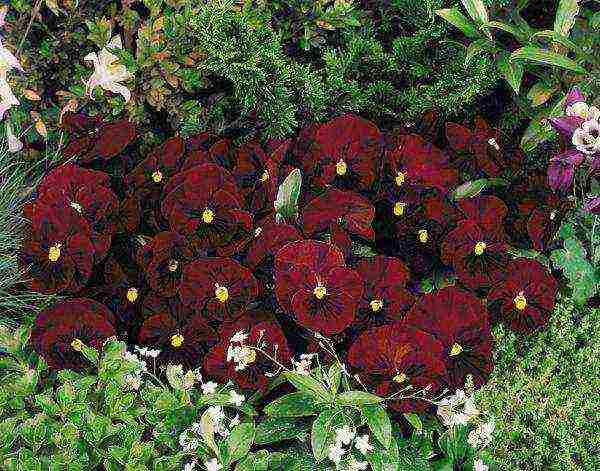 Crown F1
Crown F1
- Power F1... The petals of plants of this species have bright colors and long flowering. The most common are 13 varieties;
- Shalon Supreme... The species is represented by only 5 varieties, the peculiarity of which is corrugated petals of various shades of purple;
- Dynamite... One of the most interesting series of violas. 13 varieties have one-color petals with a large spot of contrasting color; 10 varieties are completely monochromatic. The most unusual variety of this species is Strawberry, the flower petals of this hybrid change color depending on the air temperature.
Giant viols
Varieties of this type have flowers with a diameter of 8.5 centimeters.
- Super Majestic Giants F1. This type of pansy is represented by 8 varieties with a long flowering period. The diameter of the flowers reaches 11 centimeters with a relatively small bush size. The color of the petals is presented in a wide range from beige to purple;
- Magnum F1... The newest species in the series with early flowering. 12 varieties have been bred.
These are not all types and varieties of viols. With the help of breeding methods, new hybrids are regularly developed with unusual color and flowering characteristics.
Features of growing from seeds
Pansies are not difficult to grow, so they are great even for novice gardeners. There are two methods by which you can grow flowers - planting seeds or cuttings. Planting seeds should take into account the climate conditions as well as the planned flowering time. Crops are often sown in the summer of the previous farming season. In an unfavorable climate, it is permissible to start planting at the end of July. In regions with frequent frosts and cold summers, it is best to choose the most frost-resistant plant varieties.
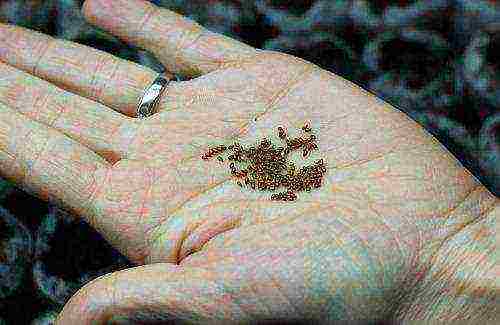 Seeds
Seeds
If you plant seeds only in early summer, there is a chance that the pansies will bloom only at the end of autumn, which increases the risk of freezing of plants. As a rule, bushes that did not bloom until the fall are better able to withstand the cold and bloom profusely the next year.
Planting seeds is best in sunny and light areas in moderately moist soil. Viols do not tolerate shade and stagnant water in the ground. In addition, it is desirable to plant the plants in the place where there were already viols, as a rule, this has a beneficial effect on the appearance of the plants. Seeds, pre-soaked, are planted with a short period, depending on the desired density of bushes. Sprouts appear two weeks after sowing. But to speed up the growth of plants, you can cover the area with flowers with plastic wrap to create a greenhouse effect. Caring for them is not difficult - you only need regular watering and loosening of the soil. Also, to stimulate the growth of green mass, you can feed the flowers with a weak urea solution.
Some gardeners plant pre-grown seedlings in prepared soil. This method reduces the risk of plant death while still in seed state and is excellent for regions with unfavorable climatic conditions.
Flowering care
During flowering, plants need special care, they need constant watering, loosening the soil, and getting rid of weeds. This improves the quality of the flowers and prolongs the flowering time.
- immediately after planting, regular loosening of the soil and daily moderate watering is necessary;
- For active plant growth and successful formation of ovaries, it is important to feed pansies. Complex mineral additives can be used as fertilizer, but the use of organic fertilizers is prohibited. Read more about the types and features of the application of mineral fertilizers here;
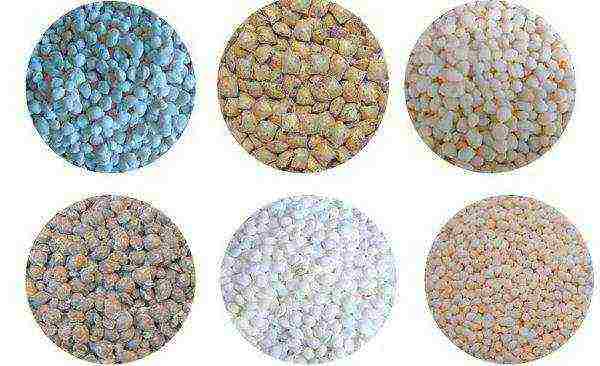 Mineral fertilizers
Mineral fertilizers
- during the flowering period, faded buds must be removed in time to allow new ones to grow. Plus, this technique allows you to avoid fruiting, which will lead to the cessation of flowering;
- when growing spring varieties of viola, after flowering, they need to be dug out, after which summer species can be planted.
Growing as an annual crop
Pansies are often used as annual flowers. To do this, the seeds must be planted in containers that are covered with transparent plastic wrap. Starting from April, you can transplant seedlings into a greenhouse or greenhouse, after a month the plants are completely ready for planting in an open, sunny place. In warm regions, planting of plants is permissible already from the beginning of spring, this will allow flowering to be achieved by mid-June. Typically, viols begin to bloom 2 months after planting.
Annual flowers are distinguished by a smaller diameter of petals and a small size of bushes. Therefore, this type of cultivation is not suitable for the formation of a large flowering lawn.
Cuttings
Many pansy hybrids can be grown by cuttings. This method allows you to preserve and improve all species characteristics of an individual.
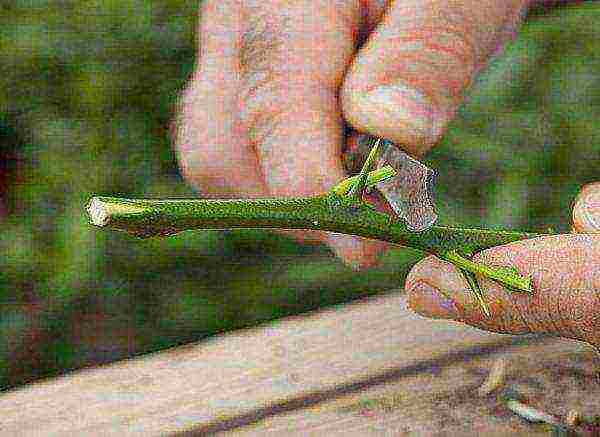 Cuttings
Cuttings
- Shoots with multiple ovaries are harvested from early May to late July. Then they are planted in prepared soil;
- Planting cuttings is desirable in well-tamped beds with high density. At the same time, it is important to monitor the depth of disembarkation, it should not exceed a few centimeters. Up to 400 plants can be planted per square meter;
- After the cuttings are in the ground, the soil must be moistened with a spray bottle or a small watering can and a complex fertilizer must be applied;
- For better color adaptation, cover the area with damp paper or a glass jar. This will protect the plants from adverse external conditions. Further care is the same as for seed planting.
With the help of cuttings, perennial plants can be rejuvenated, which lose their qualities and grow strongly over the entire area. More than 10 new plants can be obtained from one pansy bush.
Diseases and pests
While pansies are known for their resistance to disease and pests, there are a number of challenges that gardeners can face.
Among the diseases, the following are most common:
- rot - infect the stem and roots of the plant, causing blackening of the surface and wilting. With a small lesion, you can remove the infected areas of the plant, and with a significant infection, the use of fungicides is necessary;
 Rot
Rot
- powdery mildew... This problem is caused by a parasitic fungus. With the disease, small white spots appear, which grow over the entire surface of the individual. As a result, the leaves and flowers fall off. For treatment, you can use soda ash and antibiotics. As a preventive measure, you can treat the bushes with sulfur powder;
- spotting... This problem is caused by fungus. Spots of different sizes appear on the pansies, which gradually destroy the plant. Fungicides cope well with the disease.
Only regular preventive treatment and adherence to growing conditions will help to avoid the appearance of pests and diseases. Often, the appearance of a disease on one plant can lead to the death of the entire planting.
Pests are no less dangerous for viols. They tend to appear in humid climates as well as on older plants with frequent planting.
- Aphid... These are very small insects that live in large colonies. They affect the entire surface of the plant, most often the stem, and feed on its juices. As a result, the flower dies or weakens significantly. You can get rid of aphids with insecticides;
- Root gall nematodes... This is a type of worm that appears in the roots of pansies. Having settled inside the root system, they eat it from the inside. As a result, galls or swellings form on the roots, due to which the plant quickly dies. To cope with the problem is possible only with the help of insecticides. As a rule, plants need to be treated twice, since the chemicals do not affect the eggs of the nematodes;
- garden slugs... Pests eat the weight of the aerial parts of the plant. They affect not only pansies, but also other flowers on the site. To get rid of slugs, you can use soil mulching or make special baits.
Video
For an illustrative example of growing pansies from seeds, see the video
Conclusion
Pansies or viola are adorable flowers that will decorate any home garden. They have numerous colors and sizes of petals, which allows you to create whole flower pictures in your garden. Plus, these are perennial plants that, with proper care, will delight you for a single year. Read more about the varieties and cultivation of garden viola here.
Charming pansies rarely leave anyone indifferent. Today it is a flower actively cultivated to decorate flower beds in summer cottages, in city parks. The ancestor of the Viola genus, to which the pansy flowers belong, is considered a medium-sized field wild-growing plant.
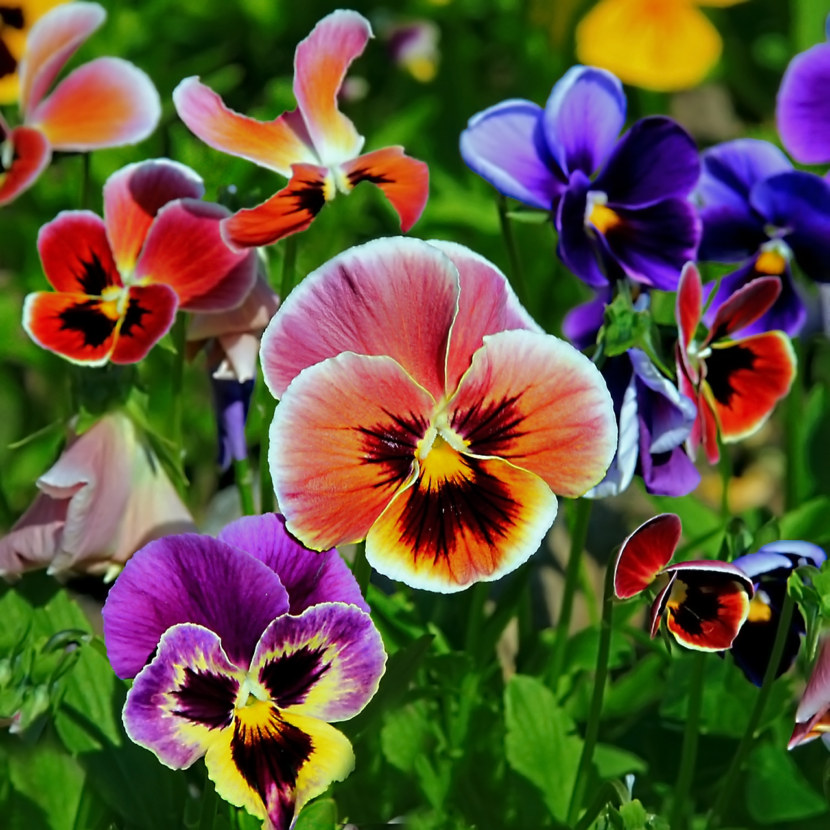
Domesticated varieties, of which there are more than 250, the larger ones reach a height of up to 30 cm. Large bright flowers invariably attract attention. The plant does not require complex care.
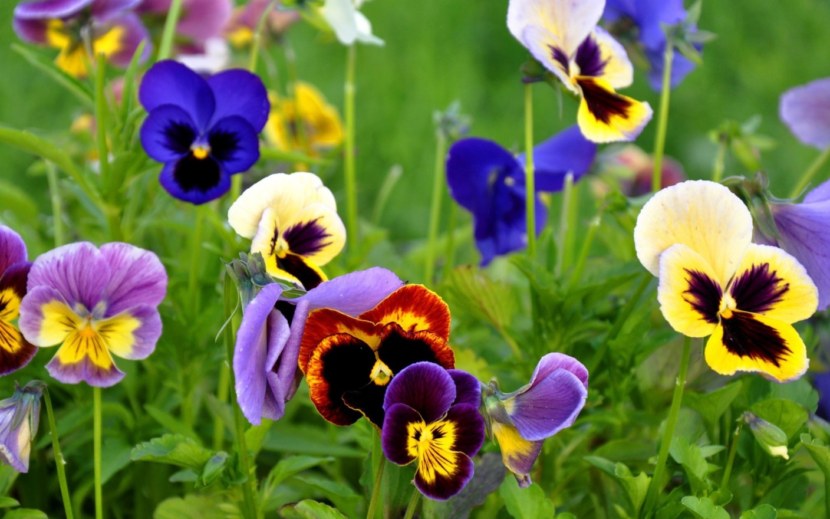
There are annual, biennial, perennial pansy flowers.A variety of colors allows you to create a flower bed for every taste.
Features of care for pansies
In order for a lush, long flowering to please the eye, the following care features must be taken into account:
- a sunny place that is illuminated and warmed up by gentle rays for at least 6 hours a day is the best choice for the growth of this flower;
- watering is carried out weekly, shifting the humidification schedule depending on the current weather conditions;
- feeding is carried out at the same frequency as watering, since the plant requires strength for an active set of buds, long flowering;
- the flower is highly resistant to cold, therefore it is able to survive even with slight frosts;
- it is worth waiting for flowering only in the 2nd year, since in the 1st year the plant is only gaining green mass.
Growing pansies
Pansies are an unpretentious plant, but planting and care require attention, adherence to some rules.

Neglecting the recommendations will lead to a reduction in the quantity, quality of flowers, deterioration of the condition and even death of the plant.
Planting pansies
To get flowering quickly, experienced gardeners recommend planting in mid-summer. To begin with, the seeds of pansies are planted on seedlings indoors. As soon as the heat subsides, the plants grow up - they are transferred to open ground.

Seedlings are placed at a distance of 20-25 cm, since subsequently the bush increases significantly in size. The plant should be transferred along with the root soil. The planting depth should correspond to the size of the clod of earth on the roots.
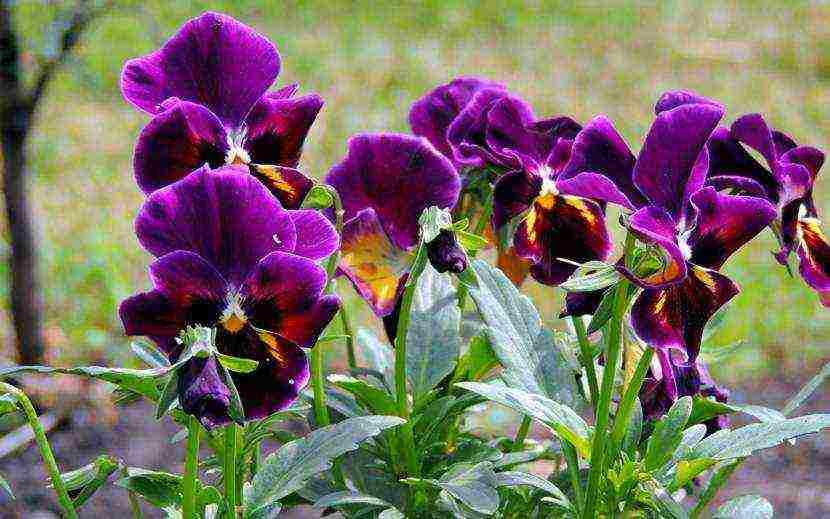
The main condition for planting is the absence of sunlight when the seedlings are moved. The soil must be moist and fertilized. Until the plant takes root, it is necessary to ensure regular watering. The soil around the planted plants is mulched. Seedlings are protected from wind and cold.
Features of caring for adult plants
Planting and caring for pansies is not particularly difficult, but for the well-being of the plant, some recommendations must be followed:
- the soil for flowers should be soft, fertilized, and regularly loosened;
- the plant is provided with frequent feeding and watering, while the soil must have time to dry out, since root rot may occur;
- it is better to shade the plant from direct sunlight, since heat slows down the development of buds, reduces the intensity and duration of flowering;
- the place of growth provides aired, does not allow stagnation of water, the formation of an earthen crust;
- it is necessary to form a bush - to pinch insufficiently strong shoots;
- wilted flowers are removed in a timely manner to prevent seed formation and prolong abundant flowering;
- dried specimens need to be cut off, and the bushes need to be fertilized;
- from the moment of a steady decrease in air temperature, the plant is prepared for wintering: feeding is stopped, cut off, covered with insulation (sawdust, peat).
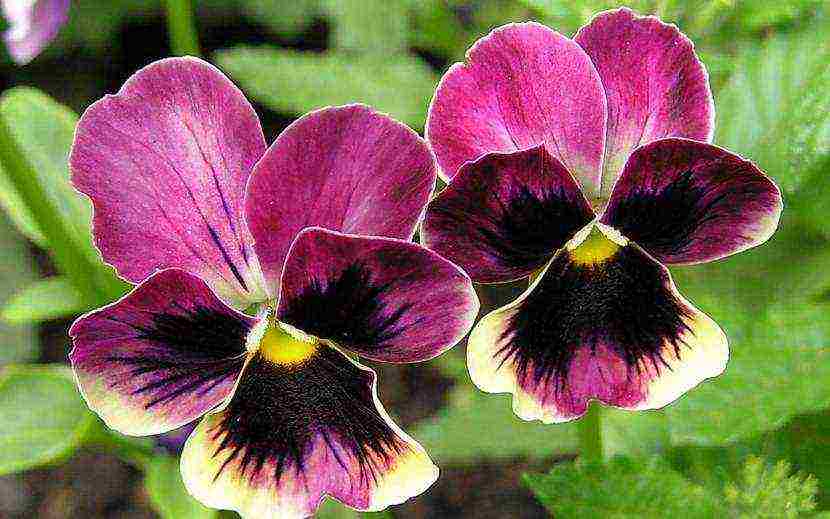
Following the recommendations will ensure long-lasting and colorful flowering.
Pansy diseases
Pansies are often susceptible to disease. The plant should be protected from diseases and pests. The main ones are called:
- powdery mildew;
- bacterial spotting;
- gray rot.
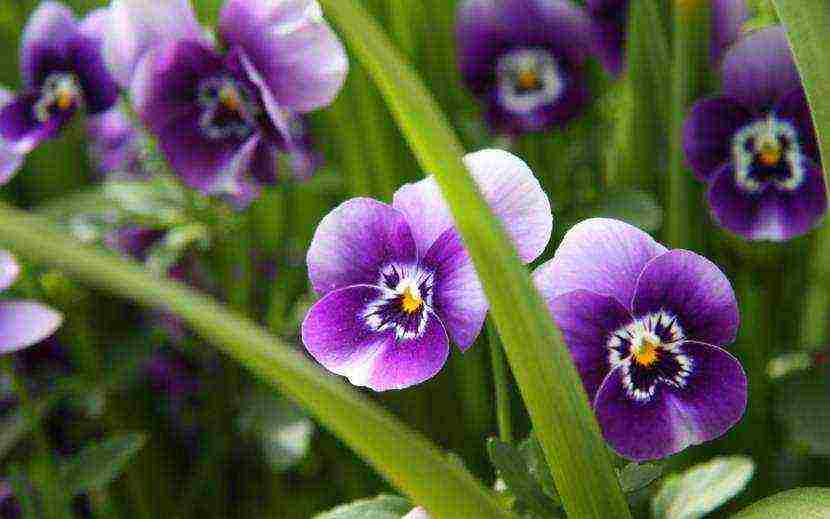
Aphids and slugs hold the palm among pansy-loving pests.

Among the unpretentious flowers, pansies take not the last place. They do not require complicated care, they respond gratefully to a caring attitude. The photo of pansy flowers shows how charming these kids are.
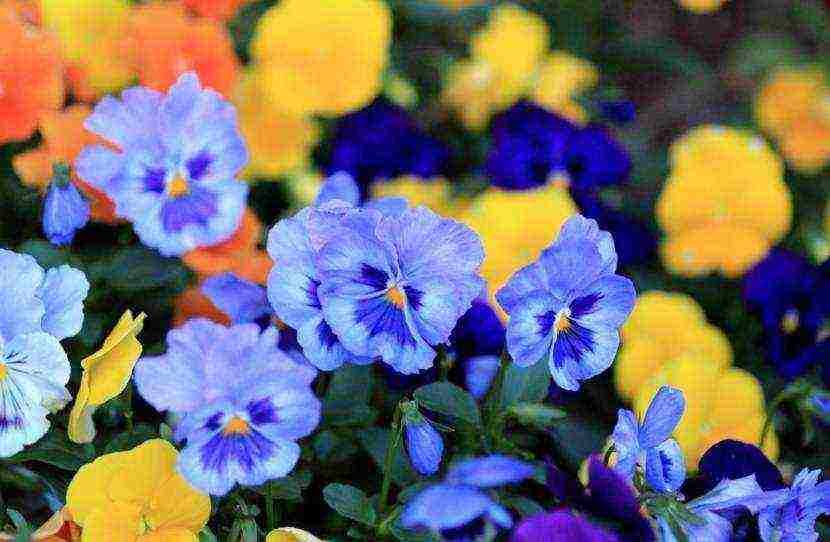
Photo of pansies
